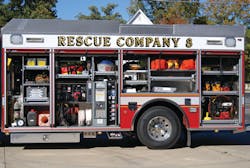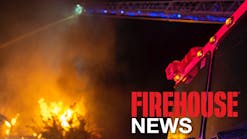Designing an apparatus to respond to technical rescue incidents is no easy task. Making the proper decisions for the needs of the apparatus is time consuming and costly. So too is the process of recognizing the types of technical rescue responses, specialized training, and the equipment needed to safely and successfully handle these situations.
The fire service responds to an array of emergency situations. One type of incident that seems to be occurring more in the fire service is the need to operate at technical rescue incidents. National Fire Protection Association (NFPA) 1670, Operations and Training for Technical Search and Rescue Incidents, categorizes rescue incidents into seven areas that can take place in any community: structural collapse, rope rescue, confined-space search and rescue, vehicle and machinery rescue, water search and rescue, wilderness search and rescue, and trench and excavation rescue. This standard should be used in the development and objectives for your department's technical rescue team. Is your department's technical rescue team prepared to handle these incidents?
Along with the apparatus selection, you must fulfill the functionality of your team. This is accomplished by specialized training in the above entities and providing the team with the tools needed to effectively conduct a rescue. With the reduction of funding and manpower, the expectations of the fire service have seemed to only increase. With proper leadership, training and the needed equipment, we can continue to accomplish our goal of safe and effective ways of serving ourselves and our communities.
Confined-space rescue operations, for example, require specialized equipment. Immediately dangerous to life or health (IDLH) air conditions can cause death in a confined space, so the air must be monitored throughout the incident. The quality of air in the space will determine the need to be on a continuous supplied-air system. Exhaust fans can also be placed outside the space to allow the exchange of air. Rescuers entering the space, along with members preparing to enter as additional rescuers or as a rapid intervention team, need to have communications and air supply in place. Many teams use a two-bottle self-contained breathing apparatus (SCBA) cart system that allows for as many as four rescuers to be on air at the same time. These systems permit 300 feet of supplied-air hose to be attached to each rescuer during the operation. Along with supplied air, rescuers need an emergency escape breathing device (EEBD) for use in the event of a failure of the supplied-air system. Most EEBDs are designed with 10- or 15-minute cylinders of air to be used to let a rescuer leave the confined space safely.
The communications needs of rescuers to the outside of the space are typically met by using an intrinsically safe hardline radio system. Portable radios or handi-talkies can be used, but using a hardline radio system proves to be more dependable and allows the rescuer ease in communicating. A bone microphone and head harnesses with the speakers work well with SCBA masks and rescue helmets.
Rescuers must be in a Class III full-body harness while operating in a confined space, as per Occupational Safety and Health Administration (OSHA) Standard 1910.146. Ropes must be attached to rescuers throughout the operation for safety and retrieval. Once rescuers have gained access to the victim, packaging techniques must be considered.
A hasty harness made of webbing or a manufactured harness should be applied to the victim during removal. Once the victim is packaged, they must be extricated by using a retrieval system. Retrieval systems vary depending on whether the rescue is horizontal or vertical. In a horizontal confined-space rescue, a simple mechanical-advantage rope system requires less effort by rescuers inside the space to extract the victim. Using manpower on the outside of the space on the haul system is a more effective way of bringing the victim and rescuers out. Static kernmantle rope of half-inch diameter is used for the rescuer and the retrieval system used during the victim removal.
During a vertical confined-space rescue, a retrieval system using a tripod, A-frame or ladder gin may be needed to extricate the victim and rescuers. With any of the above-mentioned retrieval systems, a haul system is usually added to allow better management and control in bringing the rescuer and victim out. A 4:1 mechanical-advantage system is affixed to the high point of the retrieval system to let rescuers be lowered and to bring the rescuers and victim out. Hauling systems for rescue operations should be stored on the apparatus as a complete system. By having the systems pre-rigged, the team can locate the proper bag on the apparatus and quickly attach it to the high point of the retrieval device. Many rescue teams have vehicle-mounted or portable winches, but the use of mechanical winches is not recommended when dealing with life safety.
Along with the above equipment, many pieces of rescue rope hardware are needed. Carabiners, rescue racks, pulleys, webbing, prusik cord, anchor and eight plates are some of the other specialized pieces of equipment needed to conduct a safe and effective confined-space rescue. A search-and-rescue (SAR) rope bag is an efficient way to carry and manage rope and hardware needed for this type of rescue.
Rope rescue is another technical rescue incident a rescue team must prepare for. A fire department's response area may not have skyscrapers or deep gorges, where many rope rescues would take place, but rope-rescue incidents can involve low-angle locations, scaffolding, gorges, bridges, utility towers, cranes or industrial smokestacks, to name a few. Many of the skills and techniques achieved through this specialized training are used during both confined-space and rope-rescue incidents. However, the equipment needed and skills obtained for rope rescues must be part of the technical rescue team's operation. Much of the equipment needed for a confined space incident also will be used at a rope-rescue incident.
Class II and Class III harnesses are recommended for use in rope-rescue operations. Static kernmantle rope is used for the main and belay lines. Some cut rope to varied lengths while others carry large spools of rope (600 to 1,000 feet) and then cut it to the length needed. SAR rope bags give the rescuers the rope and hardware needed to anchor and put a system together. Pickoff straps, edge protection, webbing, prusik cord, mariner straps, and belay and ascending devices are added to the team's equipment cache. Communications for these incidents are most often accomplished by using the team's portable radios.
Depending on the environment a team responds to, a device that can propel the rope (rope gun) over a very wide area (gorge or natural depression) will be needed where a high line would be used. Patient-packaging devices that may be used for a rope rescue are the same as those used for victims involved in confined-space incidents.
Achieving the objectives of a technical rescue team is a continuing process. A team's ability to maintain staffing, training, new equipment and attitude to stay sharp is of the utmost importance. These incidents typically are not an everyday occurrence, but when they occur, a team must meet the goals established when the team was organized.
JERRY MAZURKIEWICZ Jr. is a Fire Protection Specialist for the New York State Office of Fire Prevention and Control, assigned to the Special Services Bureau. He also is a firefighter with the Berwyn Heights Volunteer Fire Department in Prince George's County, MD. He may be contacted at [email protected].






